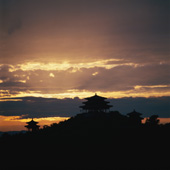|
Jingshan Park
By ,
Updated: 2004-01-14 16:08  Located to the east of Beihai Park and north of the
Imperial Palace, Jingshan Park is another beautiful spot to visit. Now covered
in fruit trees, pines and cypress trees, the hill was originally made with the
earth from the moat surrounding the Forbidden City. From the top there are
wonderful views of Beijing, especially over the Forbidden City, hence its name,
which means "Scenic Hill." The park was an imperial garden during the Yuan (1271
- 1368), Ming (1368 - 1644) and Qing (1644 - 1911) dynasties. Located to the east of Beihai Park and north of the
Imperial Palace, Jingshan Park is another beautiful spot to visit. Now covered
in fruit trees, pines and cypress trees, the hill was originally made with the
earth from the moat surrounding the Forbidden City. From the top there are
wonderful views of Beijing, especially over the Forbidden City, hence its name,
which means "Scenic Hill." The park was an imperial garden during the Yuan (1271
- 1368), Ming (1368 - 1644) and Qing (1644 - 1911) dynasties.
The main sites of interest in the park include the Hope Tower "xiwanglou,"
where people still worship at a memorial tablet for Confucius, which is in the
Keeping Benevolence Hall (yong'endian). The Visiting Virtue Hall (guandedian),
to the north of the hill, is where the coffins of the Qing emperors and
empresses lie. The 43-metre-high Million Spring Pavilion (Wanchunting) sits atop
the hill. From here it is possible to appreciate a spectacular 360 degree vista
of the city of Beijing. Directly to the north is Di'anmen Street, running
straight as an arrow up to the Drum and Bell Towers (zhonggulou); to the east is
the Yonghegong Lamasery, the Imperial College, and the Confucian Temple; to the
west is Beihai Park, where the White Pagoda rises above a blue lake full of
boats; and to the south is the Imperial Palace.
Since the founding of the
People's Republic of China in 1949, the park has been renovated several times.
It is now famous for its peony flowers.
Apart from its flowers and views,
the park is also remembered for a Chinese scholar tree that used to grow on the
eastern slope of the hill. It was from this tree that the last emperor of the
Ming Dynasty, Chongzhen, hung himself. The Emperor Chongzhen took shelter in the
park in 1644, when Lizicheng took Beijing for the Manchus who were to found the
Qing Dynasty. Having shamed his ancestors by his defeat, Chongzhen committed
suicide by hanging himself on the Chinese scholar tree. The tree no longer
survives as it was destroyed in subsequent upheavels.
|